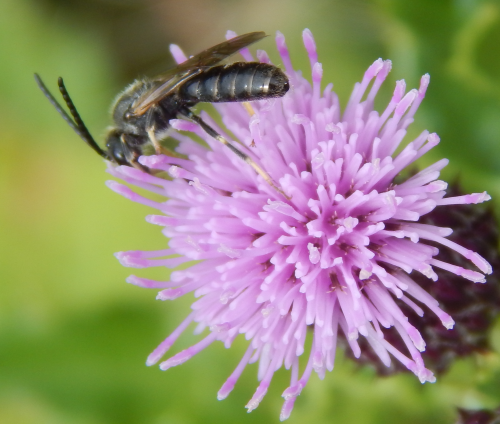Chalk Furrow Bee - Lasioglossum fulvicorne
Many solitary bees species don't conform to the usual image of a bee for most people. I suspect the Chalk Furrow Bee - Lasioglossum fulvicorne - especially the male, is one such species.
About The Chalk Furrow Bee - Lasioglossum fulvicorne
This group of bees ('Lasioglossum') are also known as 'base-banded furrow bees' and according to Falk, author of Field Guide to Bees Of Great Britain And Ireland it's the world's largest bee genus.
According to Wilson & Messinger Carril - authors of The Bees In Your Backyard, 'Lasioglossum' means 'hairy tongue' in Greek.

The sizes of bees in this genus can range from tiny to about the size of a honey bee, and this particular species. Lasioglossum fulvicorne, is a smallish bee, measuring about half a centimetre, and is easily missed on flowers, unless you are an avid bee goggler, or take a general interest in all 'insecty' type things.
If you want to spot this species yourself, check the wildflowers around brownfield sites - one of my favourite places to look, and around wooded areas.
It won't surprise you to know that wildflowers around chalk (and limestone) landscapes are also a good bet.
All of these types of habitat form part of the landscape of my local area, so it's no surprise that this bee should have found its way to my region.
I managed to snap the male above on knapweed a few years ago, whilst ambling down a country lane around the corner from where I live, and actually misidentified it. Never mind, I eventually spotted my own error, and have now corrected it. Note the white markings on the legs, long slender abdomen and comparatively long antennae.
Look out for females from late March through to October, with males appearing from June onwards.
They can be spotted foraging on a range of wildflowers, with females having a liking for ground ivy, but also check willows in spring, with males visiting composites and umbellifers.
Nesting habits
Falk, notes that nesting sites have rarely been observed, but likely to occur in sparsely vegetated or cropped soils.
More articles about bees and plants
- Bees And Brambles: The Value Of Brambles To Bees Also known as blackberry bush, research shows each bramble flower secretes lots of nectar for bees!
- Bees And Bee Balm Bee Balm (Monarda) - also known as 'Bergamot) is a herbaceous perennial which is attractive for bees.
- 30 Fantastic Garden Flowers For Bees Flowering plant recommendations for the perfect bee garden.
- Bees love lupins – but so do slugs and snails, so what can you do? Here's a way to protect your lupins....using garlic!
- Plant Oregano For Bees (Marjoram) It's rich in nectar, and attracts bees, butterflies and hoverflies in summer. Here's how to plant it.
- Fennel Pollen And Nectar Bees love fennel! How to grow it, gather it, and the many uses of fennel seeds and pollen.
If you found this page helpful or interesting, I'd really be grateful if you would share it with others - if not this page, perhaps another, such as Gardening For Bees.
Thank you so much :) .